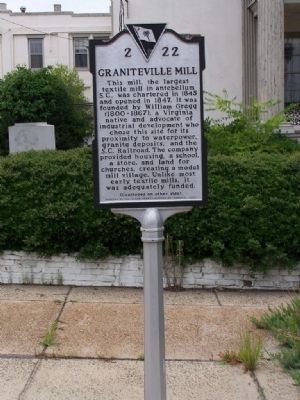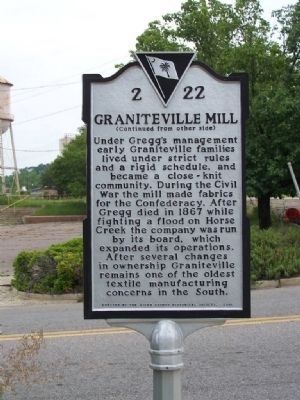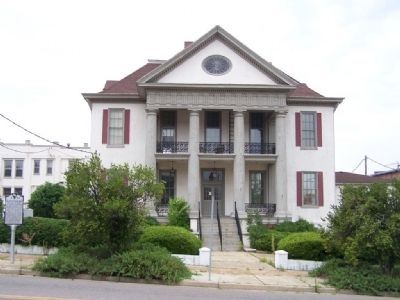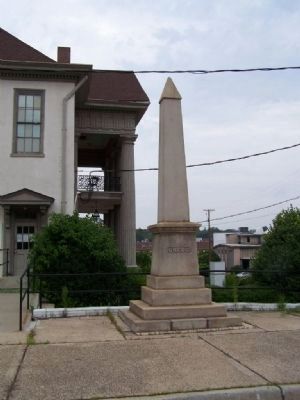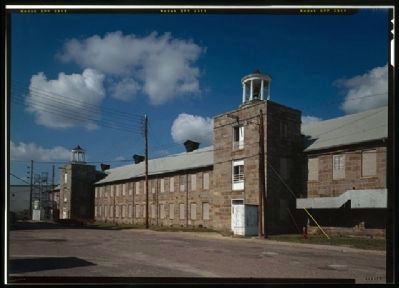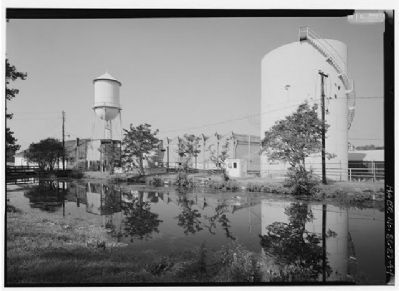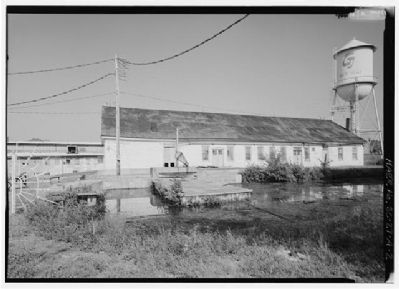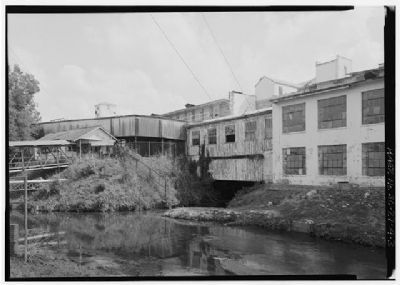Graniteville in Aiken County, South Carolina — The American South (South Atlantic)
Graniteville Mill
Inscription.
This mill, the largest textile mill in antebellum S.C., was chartered in 1845 and opened in 1847. It was founded by William Gregg (1800–1867), a Virginia native and advocate of industrial development who chose this site for its proximity to waterpower, granite deposits, and the S.C. Railroad. The company provided housing, a school, a store, and land for churches, creating a model mill village. Unlike most early textile mills, it was adequately funded.
Under Gregg’s management early Graniteville families lived under strict rules and a rigid schedule, and became a close-knit community. During the Civil War the mill made fabrics for the Confederacy. After Gregg died in 1867 while fighting a flood on Horse Creek the company was run by its board, which expanded its operations. After several changes in ownership Graniteville remains one of the oldest textile manufacturing concerns in the South.
Erected 2001 by Aiken County Historical Society. (Marker Number 2-22.)
Topics and series. This historical marker is listed in these topic lists: Industry & Commerce • Railroads & Streetcars • Settlements & Settlers • War, US Civil. In addition, it is included in the South Carolina, Aiken County Historical Society series list. A significant historical year for this entry is 1845.
Location. 33° 33.96′ N, 81° 48.495′ W. Marker is in Graniteville, South Carolina, in Aiken County. Marker is on Marshall Street near Canal Street, on the right when traveling east. Touch for map. Marker is at or near this postal address: 128 Marshall St, Graniteville SC 29829, United States of America. Touch for directions.
Other nearby markers. At least 10 other markers are within 3 miles of this marker, measured as the crow flies. 200th Anniversary of the United States (a few steps from this marker); William Gregg (within shouting distance of this marker); Graniteville Train Derailment (about 600 feet away, measured in a direct line); Leavelle McCampbell School (about 700 feet away); Farm Bell (approx. 0.4 miles away); Graniteville Cemetery (approx. ¾ mile away); WW I Memorial (approx. 0.8 miles away); Pickens - Salley House (approx. 2.2 miles away); Robert M. Bell Parkway (approx. 2.4 miles away); Kalmia (approx. 2.8 miles away). Touch for a list and map of all markers in Graniteville.
Regarding Graniteville Mill. National Register of Historic Places:
Graniteville Historic District *** (added 1978 - District - #78002491) •
Historic Significance: Event, Architecture/Engineering, Person •
Architect, builder, or engineer: Gregg,William, White,J.B. •
Architectural Style: Other, Gothic Revival •
Historic Person: Gregg,William •
Significant Year: 1849, 1867, 1846 •
Area of Significance: Social History, Industry, Community Planning And Development •
Period of Significance: 1825-1849, 1850-1874 •
Owner: Private •
Historic Function: Domestic, Education, Industry/Processing/Extraction, Religion •
Historic Sub-function: Institutional Housing, Manufacturing Facility, Religious Structure,
School, Single Dwelling, Water Works •
Also see . . .
1. Wikipedia entry for Graniteville, SC. Mr. Gregg required the children of mill workers to attend the public school he instituted and violators were fined. As such, Graniteville holds the distinction of having the first compulsory education system in the South. (Submitted on August 1, 2008, by Mike Stroud of Bluffton, South Carolina.)
2. Graniteville Historic District. The Graniteville Historic District consists of the Graniteville Canal, which dates to 1846; the original two and one-half story Graniteville Mill constructed of locally quarried granite and completed in 1849; twenty-six original workers’ houses in Early Gothic Revival style, most of whose exteriors are virtually unaltered; nine other units of early mill housing; the 1847 Graniteville Academy where operatives children were educated at company expense; and the Early Gothic Revival St. John’s Methodist Church, designed by Charleston architect E.B. White and completed in 1849. (Submitted on September 17, 2008, by Brian Scott of Anderson, South Carolina.)
3. William Gregg. William Gregg (1800-September 13, 1867) was an ardent advocate of industrialization in antebellum Southern United States. (Submitted on March 15, 2009, by Brian Scott of Anderson, South Carolina.)
4. The Story Of William Gregg And The Graniteville Mill. (Submitted on January 4, 2024, by Tom Bosse of Jefferson City, Tennessee.)
Additional commentary.
1. Graniteville Mill
This 2 1/2-story, eastward-facing factory, completed in 1849, is constructed of locally-quarried blue granite. Measuring 100 by 350 feet, the rectangular-shaped edifice rests on stone foundations and features a partial basement. The unornamented exterior walls are capped with a tin roof that is coated with tar and gravel and broken with skylights which have been covered with tin recent years. Two square-shaped stone entrance towers with rectangular window and door openings project from the building's front (east) facade. These three-story structures are capped with small white-painted wood cupolas with conical roofs. One of these contains a bell dating back to 1849. It was used to summon employees to work. Like most currently operating older textile mills, this factory's windows have been bricked in to allow the installation of air conditioning. The windows were set in rectangular surrounds and featured stone slipsills and lugsills. The only other major exterior alteration occurred in the early 1940s when the rear (west) wall was carefully taken down so that the width of the plant could be increased from its original 50 feet to the present 100. The original stone work was then put back into place, practically restoring this section to its original appearance. Presently, the mill is used to weave denim and to manufacture flannel for work gloves. Originally in a park-like setting, this factory today is surrounded by numerous other buildings belonging to the Graniteville Company. It is in good condition and well-maintained. (Source: National Register nomination form.)
— Submitted January 9, 2011, by Brian Scott of Anderson, South Carolina.
Credits. This page was last revised on January 8, 2024. It was originally submitted on August 1, 2008, by Mike Stroud of Bluffton, South Carolina. This page has been viewed 4,316 times since then and 167 times this year. Photos: 1, 2, 3, 4. submitted on August 1, 2008, by Mike Stroud of Bluffton, South Carolina. 5. submitted on May 8, 2012, by Mike Stroud of Bluffton, South Carolina. 6, 7, 8. submitted on May 26, 2010, by Mike Stroud of Bluffton, South Carolina. • Kevin W. was the editor who published this page.
